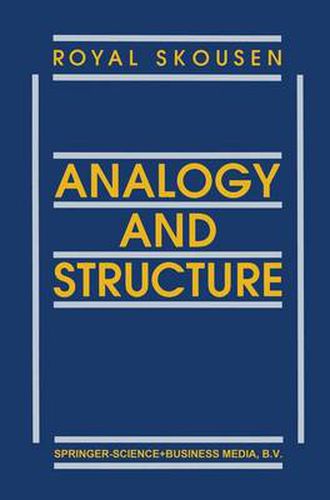Readings Newsletter
Become a Readings Member to make your shopping experience even easier.
Sign in or sign up for free!
You’re not far away from qualifying for FREE standard shipping within Australia
You’ve qualified for FREE standard shipping within Australia
The cart is loading…






This title is printed to order. This book may have been self-published. If so, we cannot guarantee the quality of the content. In the main most books will have gone through the editing process however some may not. We therefore suggest that you be aware of this before ordering this book. If in doubt check either the author or publisher’s details as we are unable to accept any returns unless they are faulty. Please contact us if you have any questions.
Analogy and Structure provides the necessary foundation for understanding the nature of analogical and structuralist (or rule-based) approaches to describing behavior. In the first part of this book, the mathematical properties of rule approaches are developed; in the second part, the analogical alternative to rules is developed. This book serves as the mathematical basis for Analogical Modeling of Language (Kluwer, 1989). Features include: A Natural Measure of Uncertainty: The disagreement between randomly chosen occurences avids the difficulties of using entropy as the measure of uncertainty. Optimal Descriptions: The implicit assumption of structuralist descriptions (namely, that descriptions of behavior should be corrected and minimal) can be derived from more fundamental statements about the uncertainty of rule systems. Problems with Rule Approaches: The correct description of nondeterministic behavior leads to an atomistic, analog alternative to structuralist (or rule-based) descriptions. Natural Statistics: Traditional statistical tests are eliminated in favor of statistically equivalent decision rules that involve little or no mathematical calculation. Psycholinguistic Factors: Analogical models, unlike, neural networks, directly account for probabilistic learning as well as reaction times in world-recognition experiments.
$9.00 standard shipping within Australia
FREE standard shipping within Australia for orders over $100.00
Express & International shipping calculated at checkout
This title is printed to order. This book may have been self-published. If so, we cannot guarantee the quality of the content. In the main most books will have gone through the editing process however some may not. We therefore suggest that you be aware of this before ordering this book. If in doubt check either the author or publisher’s details as we are unable to accept any returns unless they are faulty. Please contact us if you have any questions.
Analogy and Structure provides the necessary foundation for understanding the nature of analogical and structuralist (or rule-based) approaches to describing behavior. In the first part of this book, the mathematical properties of rule approaches are developed; in the second part, the analogical alternative to rules is developed. This book serves as the mathematical basis for Analogical Modeling of Language (Kluwer, 1989). Features include: A Natural Measure of Uncertainty: The disagreement between randomly chosen occurences avids the difficulties of using entropy as the measure of uncertainty. Optimal Descriptions: The implicit assumption of structuralist descriptions (namely, that descriptions of behavior should be corrected and minimal) can be derived from more fundamental statements about the uncertainty of rule systems. Problems with Rule Approaches: The correct description of nondeterministic behavior leads to an atomistic, analog alternative to structuralist (or rule-based) descriptions. Natural Statistics: Traditional statistical tests are eliminated in favor of statistically equivalent decision rules that involve little or no mathematical calculation. Psycholinguistic Factors: Analogical models, unlike, neural networks, directly account for probabilistic learning as well as reaction times in world-recognition experiments.